Aggressive freshwater fish make an appealing option to many fish keepers because they are highly intelligent and full of personality. Unfortunately, the scary reputation earned by some aggressive fish can be off-putting to some hobbyists.
In most cases, aggressive behavior can be managed by keeping your fish safe, happy, and healthy. In this article, we will cover how to do that, as well as present our list of 25 aggressive freshwater fish for your aquarium!
25 Aggressive Fish For Every Tank
Having taken a look at how to care for aggressive fish, let’s take a look at a couple that have caught our eye. Here are our top 25 picks!
Semi-Aggressive Freshwater Fish
1. Angelfish

Average adult size: 6 inches
Average life span: 10 years
Diet: Omnivorous
Minimum aquarium size: 55 gallons
Water temperature: Between 78° and 84° F
Angelfish are mid-sized fish that are prized for their unique and distinctive shape. These colorful fish are some of the most popular freshwater fish in the world.
Though these fish are generally peaceful, they have a tendency to exhibit semi-aggressive behavior when it comes to mating. They may also attempt to eat fish that are smaller than them.
Want to know the difference between male and female angelfish? You can learn more here.
2. Gouramis

Average adult size: 2-12 inches depending on species
Average life span: 5 years
Diet: Omnivorous
Minimum aquarium size: 55 gallons
Water temperature: Between 75° and 80° F
A small, colorful fish originating from Asia, Gouramis are known as labyrinth fish due to their ability to breathe air from the surface of the water.
These fish are aggressive and should be housed with fish with similar temperaments. Steer clear of tank mates with long, flowing fins, as gouramis are notorious fin-nippers.
3. Afer Knife

Average adult size: 24 inches
Average life span: 15 years
Diet: Carnivorous
Minimum aquarium size: 100 gallons
Water temperature: Between 75° and 80° F
The Afer Knife fish is widely loved for its beautiful shape and markings. However, hobbyists need to keep in mind that they are a rather aggressive bunch.
Charming as they are, these fish have no qualms about attacking their tankmates for territorial reasons. They should only be kept with fish that are large and bold enough to fend for themselves.
4. Severums
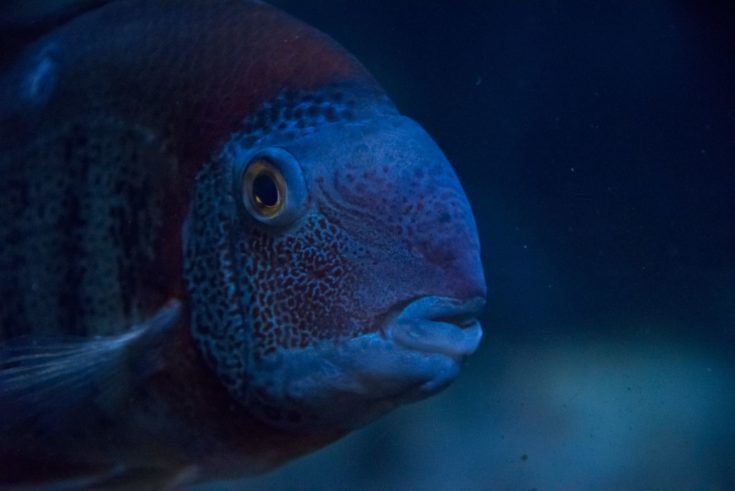
Average adult size: 7 inches
Average life span: 10 years
Diet: Omnivorous
Minimum aquarium size: 55 gallons
Water temperature: Between 77° and 82° F
Severums are a type of laterally compressed fish from the cichlid family. In general, these semi-aggressive fish get along well with like-minded fish. However, we recommend keeping a close eye on tank dynamics to keep your fish safe.
In cases where severums do not get along with their tankmates, you may want to consider housing them in a solo tank.
5. Plecostomus
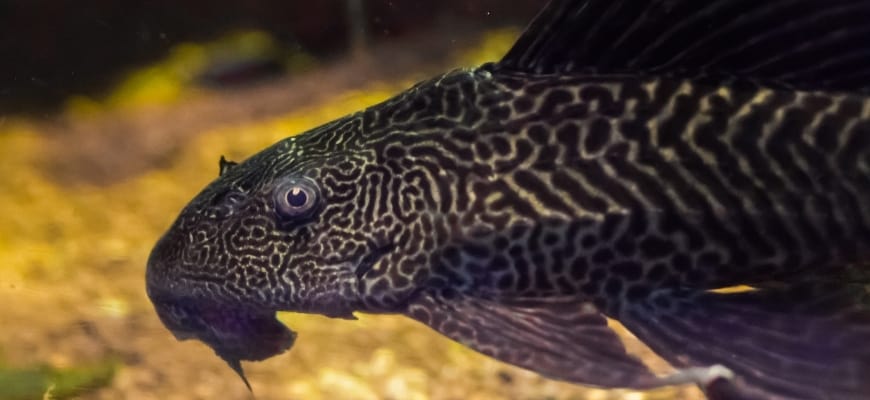
Average adult size: 15 inches (In captivity)
Average life span: 10 – 15 years
Diet: Omnivorous
Minimum aquarium size: 80 gallons
Water temperature: Between 72° and 78° F
Otherwise known as freshwater plecos, these fish are well-known for being algae eaters that will help keep your tank clean.
These fish are fairly peaceful, and can usually be kept in community tanks. However, they may act aggressively towards other plecos.
6. African Leaf Fish
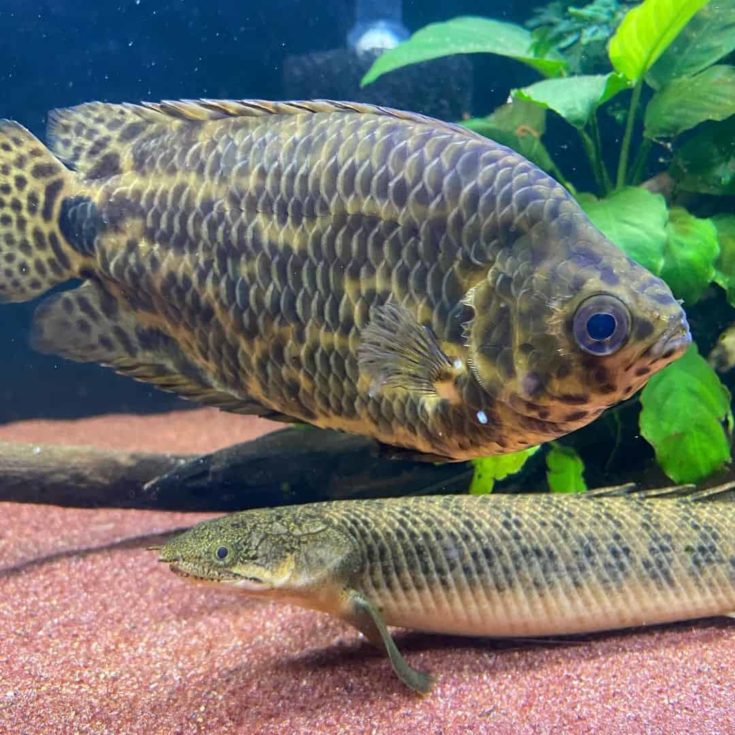
Average adult size: 7 inches
Average life span: 10 years
Diet: Carnivorous
Minimum aquarium size: 30 gallons
Water temperature: Between 78° and 89° F
African Leaf Fish rely on their superior camouflage abilities to track and hunt their prey, earning them a reputation for being opportunistic feeders.
As their name would suggest, these fish originate from West and Central Africa, and take on the appearance of a dead leaf. These unique characteristics have made it popular with dedicated fish enthusiasts.
7. Jewel Cichlid
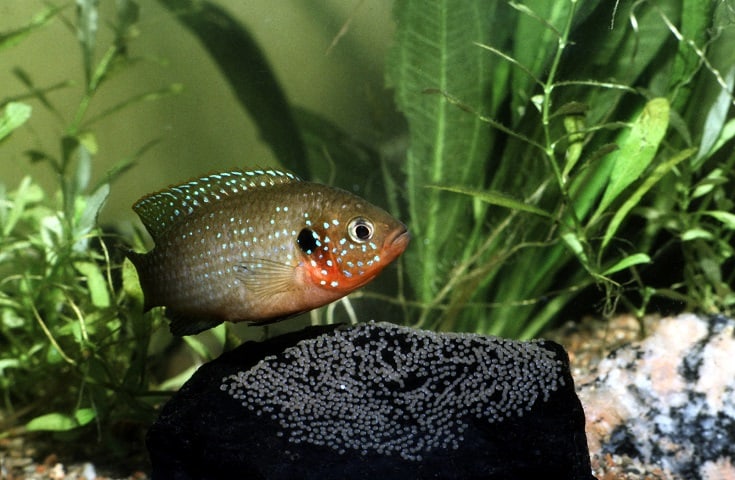
Average adult size: 2 – 10 inches depending on variety
Average life span: 5 years
Diet: Omnivorous
Minimum aquarium size: 30 gallons
Water temperature: Between 74° and 80° F
Jewel Cichlids may disarm you with their harmless, colorful appearance at first, but don’t be fooled – they are very feisty.
These fish are notorious fin-nippers and have a tendency to chase smaller fish. However, their tendencies can be easily managed as long as their needs are met.
8. Bichir

Average adult size: 38 inches
Average life span: 15 years
Diet: Carnivorous
Minimum aquarium size: 90 gallons
Water temperature: Between 75° and 82° F
Bichirs are a type of reedfish that resemble eels. These fish have multiple dorsal fins on their backs, giving them a distinctive appearance.
These fish are not very aggressive, but they are predatory. While they will prey on smaller fish, they make excellent tank mates for aquariums housing larger, more peaceful fish such as Oscars, catfish, and knife fish.
9. Convict Cichlid
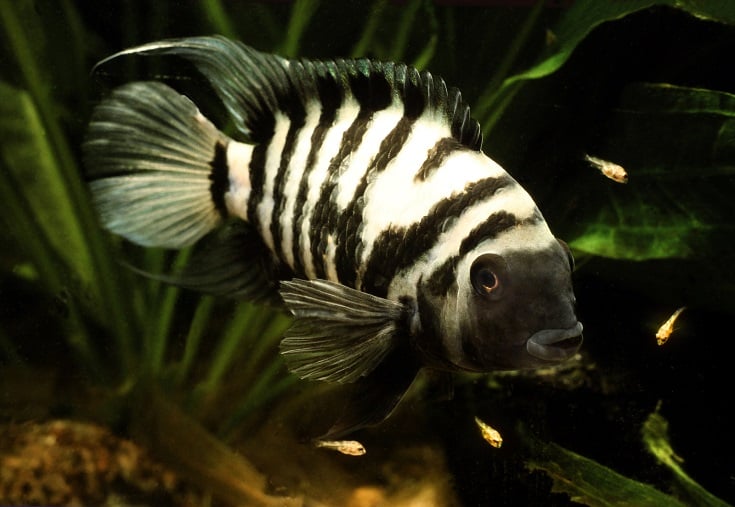
Average adult size: 4.5 inches
Average life span: 8 years
Diet: Omnivorous
Minimum aquarium size: 40 gallons
Water temperature: Between 79° and 84° F
Convict Cichlids are known to be aggressive and territorial but can make stellar community fish when placed among peers who can stand their ground, such as barbs.
Because these fish are extremely hardy, they are also appropriate for beginners. Just be sure to place them in a spacious tank as they can be rather messy!
10. Black Wolf-Fish
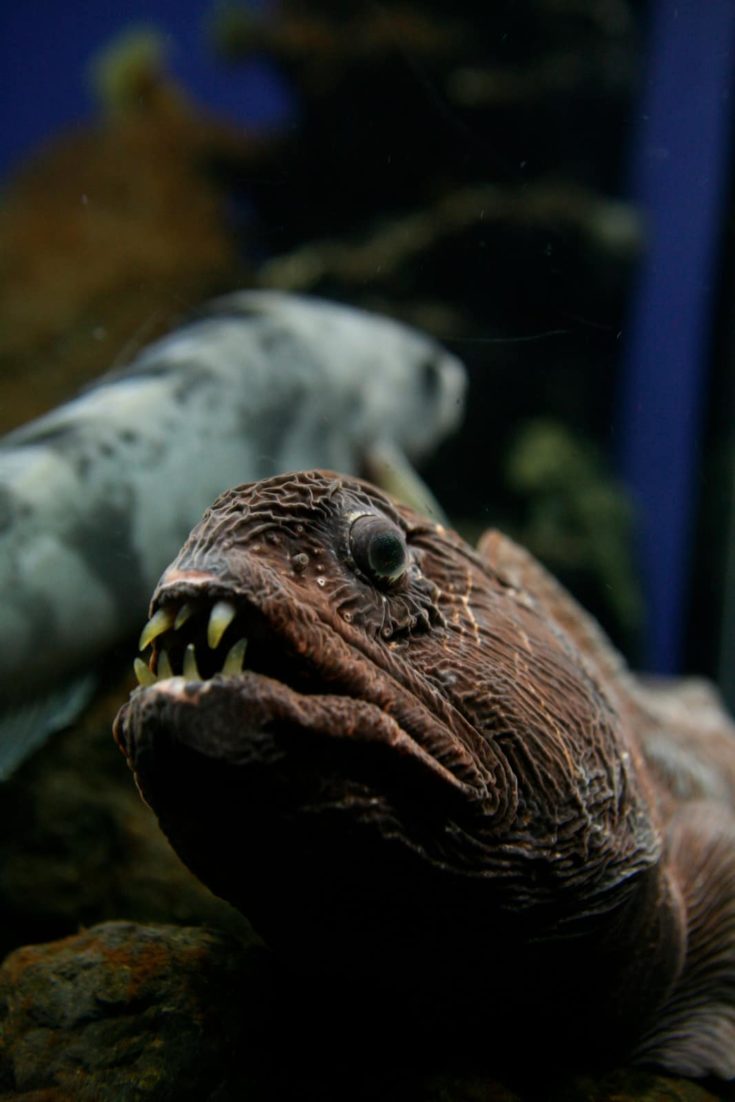
Average adult size: 16 inches
Average life span: 7 years
Diet: Carnivorous
Minimum aquarium size: 120 gallons
Water temperature: Between 75° and 82° F
Black wolf-fish hail from South America, and are known to be voracious, aggressive fish that are also hardy and very interesting to observe.
In their natural habitats, they have a preference for solitude and slow-moving waters. Hobbyists hoping to provide this fish with a happy home should attempt to replicate these conditions by creating lots of caves in darkened areas of the tank.
11. Wolf Cichlid

Average adult size: 28 inches
Average life span: 30 years
Diet: Carnivorous
Minimum aquarium size: 180 gallons
Water temperature: Between 72° and 81° F
Also known as the rainbow bass or guapote, wolf cichlids are an aggressive breed of fish that hails from Central America. Because of their personality, these fish should either be kept alone or as part of a bonded pair in a dedicated aquarium.
The wolf cichlid can grow to rather impressive sizes – it is as wide as it is long. On top of that, their beautiful, iridescent bodies give them an eye-catching appeal.
12. Dwarf Pea Puffer

Average adult size: 1.4 inches
Average life span: 4 years
Diet: Carnivorous
Minimum aquarium size: 10 gallons
Water temperature: Between 77° and 79° F
If we have to pick a top contender for the most adorable fish, it would be the dwarf pea puffer without a doubt. With their diminutive, bright yellow bodies and goofy little smiles, it comes as no surprise that they have stolen the hearts of aquarists around the world.
Like their larger cousins, Dwarf Pea Puffers can have a bit of a mean streak, particularly when it comes to males of the same species. Stick to the one-male-per-tank rule, and you’re golden!
13. Jaguar Cichlid

Average adult size: 20 inches
Average life span: 15 years
Diet: Carnivorous
Minimum aquarium size: 70 gallons
Water temperature: Between 74° and 79° F
Originating from South America, the Jaguar Cichlid is an apex predator with traits that have evolved to allow them to hunt effectively. For instance, their lower jaws can protrude as much as 90% of their mouth’s length!
These fish are aggressive, but can make decent tankmates for cichlids that match their size and personality. Be sure to give your fish plenty of room in your tank to minimize the odds of a territorial dispute!
14. Bucktooth Tetra
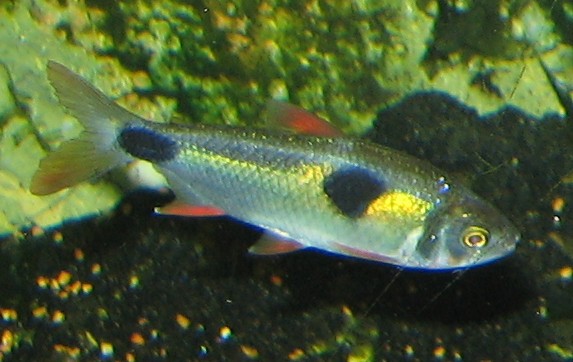
Average adult size: 5 inches
Average life span: 10 years
Diet: Carnivorous
Minimum aquarium size: 55 gallons
Water temperature: Between 73° and 80° F
The bucktooth tetra is notable for its interesting feeding habits. These fish are not predators in the conventional sense – they do not eat their prey whole, but opt instead to feast on the outermost layer of their skin. In short, bucktooth tetras are scale-eaters.
Though feisty, these are unlikely to attack each other if the numbers are large enough. Instead, they will be perfectly content surviving on bloodworms, fish flakes, and other types of nutritious food sources.
Aggressive Freshwater Fish
15. Green Spotted Puffer
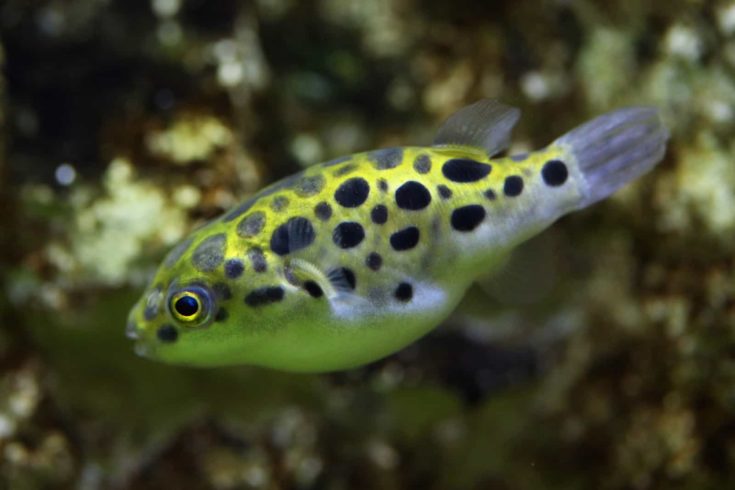
Average adult size: 6 inches
Average life span: 10 years
Diet: Carnivorous
Minimum aquarium size: 55 gallons
Water temperature: Between 78° and 82° F
With their bright-colored bodies, black spots, and goofy expression Green Spotted Puffers are absolutely adorable! Don’t be fooled by their appearance, however – these fish can give some of the more aggressive fish on our list a run for their money!
In general, Green Spotted Puffers should only be kept in a species-specific tank. While they may initially get along with tank mates such as mollies and bumblebee gobies, even the slightest perceived threat may trigger an attack
Though Green Spotted Puffers may take a lot of work, enthusiasts will attest to the fact that their charm makes all the effort worth it.
16. Flowerhorn

Average adult size: 14 inches
Average life span: 12 years
Diet: Omnivorous
Minimum aquarium size: 40 gallons
Water temperature: Between 80° and 85° F
Flowerhorns are prized by Chinese communities around the world as they are said to bring good luck and prosperity. As a distinguished member of the cichlid family, this fish sets itself apart with its distinctive bulging forehead and vivid coloration.
These fish are known to forge deep bonds with their owners. The flowerhorn’s aggressive temperament means that it is only suitable for solo tanks. This rule applies even to fish of the opposite sex.
17. Pig Nose Puffer Fish (Pao Suvattii)
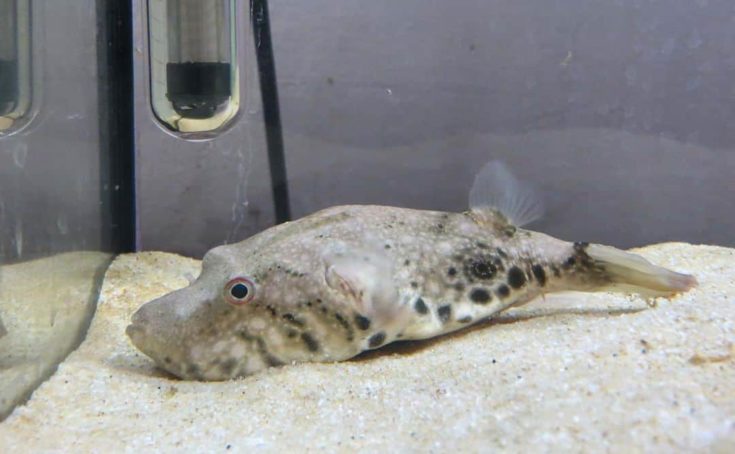
Average adult size: 6 inches
Average life span: 10 years
Diet: Carnivorous
Minimum aquarium size: 20 gallons
Water temperature: Between 75° and 82° F
The pig nose puffer fish is named after its adorable upturned nose and originates from the Mekong River in Southeast Asia. They are sometimes known as the Target Puffer because of the distinctive black dot located between its anal and dorsal fins.
These fish will sometimes bury themselves in sand or substrate, leaving only their mouths exposed. This allows them to quickly gobble up fish that swim by. Because of their beak-like mouths, they are capable of breaking their food up into smaller, more manageable pieces.
18. Betta Fish

Average adult size: 2.5 inches
Average life span: 3 years
Diet: Carnivorous
Minimum aquarium size: 3 gallons
Water temperature: Between 75° and 80° F
For fish that are relatively small and brightly colored with long, flowing fins, betta fish look more like prey than fish that have earned a feisty, territorial reputation among hobbyists.
Originating from Southeast Asia, these fish are also known as the Siamese Fighting Fish. Males are known to engage in deadly fights because they have an extremely territorial instinct. For that reason, male bettas are usually housed alone.
19. African Cichlids

Average adult size: 5 inches
Average life span: 15 years
Diet: Omnivorous
Minimum aquarium size: 30 gallons
Water temperature: Between 76° and 82° F
Originating from the rivers of Sierra Leone, Guinea, and Liberia, African Cichlids are the most famous and diverse group of fish in the cichlid family.
These attractive fish come in a wide range of colors and patterns, making them extremely popular with freshwater fish enthusiasts.
African Cichlids are mid-dwellers, so you should avoid choosing fish that prefer to swim in open waters as they are vulnerable to attacks. Large, bottom-dwelling fish such as catfish will likely make a solid choice.
20. Tiger Barb

Average adult size: 3.5 inches
Average life span: 6 years
Diet: Omnivorous
Minimum aquarium size: 20 gallons
Water temperature: Between 75° and 82° F
Originating from Southeast Asia, Tiger Barbs are hardy fish that swim in schools of 6 or more. These tiny, active fish will add a ton of life to your aquarium – you can expect to see them zipping back and forth between both ends of your tank!
Though these fish may appear harmless, they have a tendency to nip at fish with flowing fins or bother fish that are more docile. Putting them in tanks with compatible tank mates such as clown loaches would be the best way to keep things harmonious.
21. Red-Tailed Shark
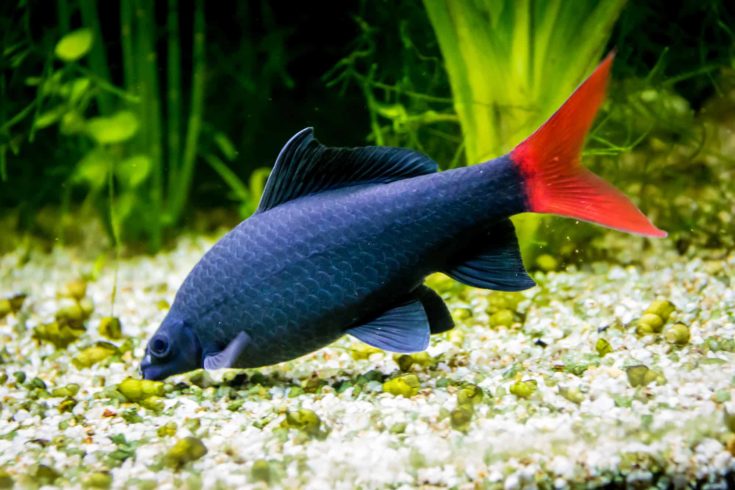
Average adult size: 4 inches
Average life span: 6 years
Diet: Omnivorous
Minimum aquarium size: 55 gallons
Water temperature: Between 72° and 79° F
The active, striking red-tailed shark is not only fun to look at, but relatively easy to care for. These omnivorous fish are not fussy when it comes to food, and can thrive on a diet of store-bought fish flakes.
In general, these fish will do okay in community setups as long as they are given sufficient space. These fish are not violent, so they won’t hurt their tankmates. However, you will want to keep an eye out for chasing, which can be stressful for more docile fish.
22. Piranha
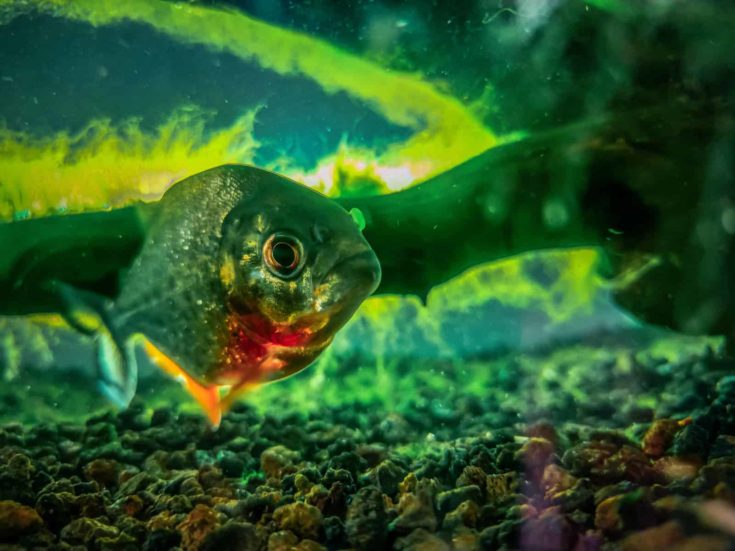
Average adult size: 10 inches
Average life span: 13 years
Diet: Omnivorous
Minimum aquarium size: 110 gallons
Water temperature: Between 76° and 83° F
Odds are, you’ve stumbled upon a movie featuring piranhas. These fish have earned a reputation for being deadly apex predators, though this is merely an exaggerated version of the truth.
Yes, piranhas can bite and hurt humans. However, this is rare – they are more likely to attack smaller fish or other injured sea creatures.
23. Rainbow Shark

Average adult size: 6 inches
Average life span: 8 years
Diet: Omnivorous
Minimum aquarium size: 30 gallons
Water temperature: Between 75° and 81° F
Also known as the red-finned shark, the rainbow shark is a deep blue or dark grey fish with striking red fins.
These tiny fish are known to be highly aggressive towards fellow sharks, particularly if they are of the same size. They may also chase or attack smaller fish.
However, with some careful planning, rainbow sharks can do relatively well in a community tank. Other types of aggressive fish that are roughly the same size would make excellent tankmates.
24. Arowana (Silver and Asian)

Average adult size: 24 inches
Average life span: 20 years
Diet: Carnivorous
Minimum aquarium size: 250 gallons
Water temperature: Between 72° and 82° F
Known as the world’s most expensive aquarium fish, it comes as no surprise that the Arowana is as stunning as it is intimidating.
These slow-producing fish have been classified as endangered species. Paradoxically, they are also one of the mass-produced fish in the world due to their widespread popularity and associations with good luck.
With its whiskers, metallic scales, and unique shape, the will could no doubt lend character and beauty to your tank. Given their reputation as apex predators, they will need to be housed alone.
25. Oscar Fish

Average adult size: 18 inches
Average life span: 10 years
Diet: Omnivorous
Minimum aquarium size: 55 gallons
Water temperature: Between 77° and 80° F
Oscars sure are a feisty bunch! These large, powerful fish have no qualms about defending their territory and should be kept in large solo aquariums. Do make sure to attach a hood to your aquarium, as these fish are notorious jumpers.
Because of their strength, these fish are likely to redecorate the tank according to their liking. This can be very fun to observe.
Why Are Fish Aggressive?
Fish often act aggressively out of necessity. Most acts of aggression transpire over food, breeding, and territory, which are all essential components of a fish’s biological needs.
Territory
Territoriality is one of the key reasons for aggressive fish behavior. Many types of fish require an area to call their own and may act aggressively to defend their territory. If your tank contains caves, pieces of driftwood, or other hiding spots, more aggressive fish will likely try to claim these areas as their own.
Food
Oftentimes, fish that act in aggressive ways are merely predatory. In their natural habitat, larger fish typically see smaller fish as food as they are lower on the food chain. This dynamic may be replicated in a home aquarium.
In other instances, fish may also act aggressively to compete for food. This is more likely to happen in crowded tanks, especially under circumstances where the fish’s needs are not adequately met.
Breeding
Male and female fish act aggressively at different stages of the breeding process. During courtship, males fight one another over female fish – often to the point of severe injury. Males may also attack fish of different species that bear a physical resemblance to them.
Female fish have a protective instinct when it comes to guarding their eggs or fry. They are likely to attack fish that come too close to their nests. It is a good idea to use birthing tanks to minimize the chances of breeding-related attacks.
What is a Semi-Aggressive Fish?
Semi-aggressive fish are fish that are docile for the most part but may act aggressively when they feel threatened. This is typically done to safeguard their resources.
In general, semi-aggressive fish can be kept in community tanks, as long as the tank is large enough with lots of hiding spaces. Do make sure to create peaceful hideouts for fish hoping to take a break from the antics of their more aggressive tankmates! Caves and broken sightlines make a world of difference.
Difference Between Semi-Aggressive and Very Aggressive Fish
There is an important distinction to make between semi-aggressive and very aggressive fish. While semi-aggressive fish may attack under select circumstances, very aggressive fish exhibit extreme territorial tendencies that require them to be housed alone.
Something you might observe is relentless chasing, particularly if their tankmates are perceived to be weaker. For that reason, they are generally not recommended for community tanks, though some may adapt to tanks containing fish of similar temperaments and sizes.
Very aggressive fish require careful handling but can make delightful, fascinating pets. However, hobbyists should do their research beforehand to understand how to best care for them. These are fish that require a heftier dose of attention.
Quick Facts About Semi-Aggressive Fish
Species
Semi-aggressive fish come in all shapes and sizes. From the minuscule tiger barbs to large gouramis, hobbyists have lots of options to choose from! Just be sure to house them in appropriately-sized tanks! These fish enjoy having their own territory.
Behavior
The thing about semi-aggressive fish is they are typically docile and calm unless their space is encroached upon. As long as you provide them with sufficient space in your tank, it is likely that they will get along with fish that are similarly sized.
Keeping Your Semi-Aggressive Population Happy
Pick the Right Aquarium
Semi-aggressive fish require dedicated spots in the tank to call their own. This means you need to select tanks of the right size. Here are a few helpful rules of thumb to help you figure out the right-sized tank to get!
Fish Size
Up to 6 inches, or 15 cm long
Minimum Tank Size
20 gallons
Fish Size
Up to 10 inches, or 25 cm long
Minimum Tank Size
29 gallons
Fish Size
Up to 20 inches, or 51 cm long
Minimum Tank Size
55 gallon
Fish Size
Over 20 inches long
Minimum Tank Size
75 gallons
In general, the larger the tank, the happier your fish. Larger tanks give your fish ample room to swim about without encroaching on another fish’s territory. This minimizes the risk of conflict.
Decorate Your Aquarium… Strategically
Semi-aggressive fish like to stake their claim on hiding spots within an aquarium, so this should be your foremost consideration when it comes to aquarium landscaping. Carve out at least one nook per fish – you can get as creative as you want with rocks and driftwood!
Hiding spots are also important if you intend to house semi-aggressive fish with more docile tankmates. Fish that are calmer may sometimes feel a need to retreat from the gregarious antics of their more aggressive tankmates. Tiny nooks are important for this purpose.
Another way to decorate strategically is to use a substrate bed that is not too deep. 2 inches is perfect. This makes it easier to keep your tank clean, which is important as aggressive fish can sometimes be larger and messier.
Pick the Right Tankmates
Picking the right tankmates is so important! While tankmate selection is pretty clear-cut for non-aggressive fish, things get a little murkier when it comes to semi-aggressive fish.
A good rule of thumb is to only keep one male member of any semi-aggressive species, per tank. It is okay to keep multiple males of different species, as long as they don’t resemble one another.
Yet another thing to remember is to pick tankmates that are roughly the same size, and have the same temperament. This is important so that every fish in your tank can hold its own in the occasional squabble.
Finally, steer clear of significantly tinier fish, as well as fish with flowy fins! Some fish are notorious fin-nippers, while others may eat other fish.
How can I keep my semi-aggressive fish healthy?
Keep Water Parameters Healthy
To keep your semi-aggressive fish healthy, you need to maintain the comfort and cleanliness of their habitat. Do so by conducting weekly water changes and by testing your water regularly. Fish living in ideal environments are healthier, happier, and less likely to act aggressively.
Maintain Filtration Efficiency
Beyond frequent water changes and testing, it is also important to maintain filter efficiency. Choose a filter that is capable of treating your water at least 3 times an hour. For instance, if you own a 30-gallon tank, you should opt for a filter that can process at least 90 gallons of water per hour. Check out our list of recommended aquarium filters for large tanks.
Feed Them A Healthy Diet
Semi-aggressive fish are typically active swimmers and require a healthy diet. In general, a diet consisting of fish flakes supplemented with live protein sources such as brine shrimp will provide them with the nutrition they need.
For fish that are non-carnivorous, it is important to balance out the protein-rich nature of their diets with plant-based food sources. While some fish may be perfectly content feeding on algae in your tank, other fish may benefit from algae discs and spirulina pellets.
Signs of Unhealthy Fish
Unfortunately, your fish may still fall ill even after you’ve done your best to take good care of them. Here are a few signs that your fish may be falling sick:
- Discoloration
- Erratic swimming patterns
- Decreased appetite
- Hiding
- Swelling
- Fin-Clamping
Fish that appear unhealthy should be quarantined and placed in a hospital tank for treatment and observation. Speak to your vet or a local fish store on the most appropriate course of action. In most cases, spotting illnesses early will save your fish!
Conclusion
Learning how to care for aggressive fish is an extremely rewarding undertaking. These colorful, feisty fish will add tons of personality to your tank! A little bit of research and knowledge goes a long way when it comes to these interesting creatures. They will make fantastic pets as long as their needs are met.
Have you ever raised aggressive fish? Let us know in the comments below! And if you know someone who is considering doing so, please feel free to send them this article! Hit us up with questions in the comments section below – we’d love to help!
